A
French Masterpiece in Finney Chapel

Parlez-vous
Cavaillé-Coll?
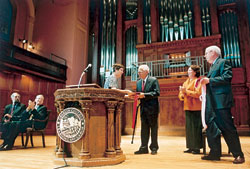
"Un
Morgue á la Micheal-ange" (a Michelangelo of an
organ). That's what Charles-Marie Widor, the great French organist,
composer, and teacher called the magnificent 1890 organ of the
church of St. Ouen in Rouen, France.
One wonders which artist M. Widor would invoke to praise Oberlin
College's new Kay Africa Memorial Organ, inaugurated over the
weekend of September 28-30, 2001. It has, you might say, the logic
and ingenuity of Leonardo da Vinci and the voluptuousness of Peter
Paul Rubens. By any standards, it's a masterpiece and one of the
most important organs built anywhere in at least a generation.
If not quite a clone of St. Ouen, Finney Chapel's new instrument
is a composite of organs built during the 1880s by the great French
artisan Aristide Cavaille-Coll. Starting in the middle of the
19th century, Cavaille-Coll's revolutionary instruments inspired
a rich "school" of French organ music, beginning with
Cesar Franck and including M.Widor, Alexandre Guilmant, Camille
Saint-Saens, Charles Tournemire, Louis Vierne, Marcel Dupre, Jehan
Alain, Olivier Messiaen, and Maurice Durufle. Even present-day
organist/composers as eclectic and controversial as Jean Guillou
and Naji Hakim clearly grow out of this tradition.
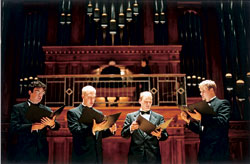 The Gloucester, Massachusetts, firm of C.B. Fisk, widely considered
the most distinguished American organ-building organization of
the last quarter century, built the new organ. With Finney Chapel
packed to the doors, it was put through its inaugural paces in
a pair of concerts featuring Oberlin organ professors Haskell
Thomson and David Boe with music written for organs of this type.
Paul Polivnick and the Oberlin Orchestra joined in the September
28 concert, in which Boe was the soloist in Oberlin alumnus Robert
Sirota's '71 "In the Fullness of Time" (2000) and Saint-Saens'
"Organ" Symphony. Thomson took the spotlight in Joseph
Jongen's Symphonie concertante. The instrument was heard
by itself on September 29, with Boe playing music of Franck, Vierne,
and Ermend Bonnal, and Thomson opting for Louis Lefebure-Wely,
Franck, Widor, Durufle, and Messiaen. On September 30 other organists,
including quite a pleiade of Oberlin alumni, were invited to sign
up for individual times to play the instrument.
The Gloucester, Massachusetts, firm of C.B. Fisk, widely considered
the most distinguished American organ-building organization of
the last quarter century, built the new organ. With Finney Chapel
packed to the doors, it was put through its inaugural paces in
a pair of concerts featuring Oberlin organ professors Haskell
Thomson and David Boe with music written for organs of this type.
Paul Polivnick and the Oberlin Orchestra joined in the September
28 concert, in which Boe was the soloist in Oberlin alumnus Robert
Sirota's '71 "In the Fullness of Time" (2000) and Saint-Saens'
"Organ" Symphony. Thomson took the spotlight in Joseph
Jongen's Symphonie concertante. The instrument was heard
by itself on September 29, with Boe playing music of Franck, Vierne,
and Ermend Bonnal, and Thomson opting for Louis Lefebure-Wely,
Franck, Widor, Durufle, and Messiaen. On September 30 other organists,
including quite a pleiade of Oberlin alumni, were invited to sign
up for individual times to play the instrument.
German composers have rarely specified registrations in their
music, but since the 17th-century French composers have told interpreters
pretty precisely what stops to draw and when to change them. From
Franck onward, the sounds they've had in their heads have been
predominantly those of Cavaille-Coll. Sure enough, the Cavaille-Coll
sonorities are recreated in Finney Chapel in all their sumptuous
colors: the plush fonds d'orgue purring like a huge cat, the "crash"
of the reeds, the penetrating intensity of the flutes harmoniques,
the tang of the cornet, the thunder of the 32-foot pedal Contre
Bombarde. These are sounds you'll hear approximated only here
and there, in isolation, outside of France. But they
animate the "symphonic" organ music of France in a compelling,
visceral way. There's a sense of rightness, of inevitability,
that can't be duplicated on a more "eclectic" instrument.
And they're unashamedly gorgeous.
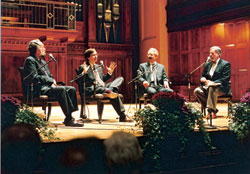 "I'm just so pleased that it has turned out so well as it
has. The flue stops particularly come together," Thomson
says. "I have to admit that my favorite stop is the flute
harmonique it's a wonderful example of that very important stop.
A French romantic organ more or less stands or falls on the way
this stop interacts with the other 8-foot flues the montre, the
gamba, and the bourdon as it gives power to the upper register,
richness throughout the compass, and makes way for the gamba to
give point to the low register. In this way it contributes greatly
to the blending of sonorities that results in a beautiful symphonic
sound."
"I'm just so pleased that it has turned out so well as it
has. The flue stops particularly come together," Thomson
says. "I have to admit that my favorite stop is the flute
harmonique it's a wonderful example of that very important stop.
A French romantic organ more or less stands or falls on the way
this stop interacts with the other 8-foot flues the montre, the
gamba, and the bourdon as it gives power to the upper register,
richness throughout the compass, and makes way for the gamba to
give point to the low register. In this way it contributes greatly
to the blending of sonorities that results in a beautiful symphonic
sound."
Acoustics can make or break an organ, and Oberlin wisely put money
into improving the position and sonic environment for the new
Fisk instrument. The magnificent new case, expanding upon woodwork
from Finney Chapel architect Cass Gilbert's original design, now
projects just in front of the proscenium. The stage has been extended
out into the room, with new sound-projecting panels angled at
the sides.
At the direction of acoustical consultant Dana Kirkegaard, bass
frequencies, in particular, are now reinforced by a new 12-inch-thick
masonry wall directly behind the organ and one-inch-thick glass
coverings on windows in the apse and first bay of the auditorium.
Sound absorptive panels have been removed from the back bays of
the ceiling, and the front three bays have been covered with convex
panels of a hard, sonically reflective material. New finned deflectors
on the back wall of the main floor break up echoes that long plagued
performers. Although a full audience still deadens and dulls the
sound noticeably, everyone who knew Finney Chapel before the changes
was thrilled at the richer, fuller, more "present" sound
heard at the inaugural festivities.
"Dana Kirkegaard did a wonderful job of enhancing the bass
and increasing the reverberation to at least what would be desirable
in a concert hall," Boe says. "Even the sound of the
orchestra was considerably improved by these changes."
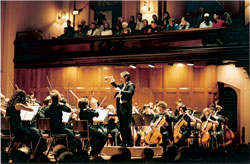 With its relatively low and busily beamed ceiling, Finney Chapel
will never have the long "roll" of reverberation all
but inseparable from the sounds of the great Cavaille-Coll organs
in Paris, Lyon, Caen, Toulouse, and Rouen. Kirkegaard thinks the
effect could still be improved by further reinforcement of the
ceiling and windows without overly muddying the sound of piano
or orchestra. But that would cost more money and require air-conditioning
the chapel.
With its relatively low and busily beamed ceiling, Finney Chapel
will never have the long "roll" of reverberation all
but inseparable from the sounds of the great Cavaille-Coll organs
in Paris, Lyon, Caen, Toulouse, and Rouen. Kirkegaard thinks the
effect could still be improved by further reinforcement of the
ceiling and windows without overly muddying the sound of piano
or orchestra. But that would cost more money and require air-conditioning
the chapel.
"There's this incredible fear among orchestral musicians
that reverberation is going to make things too muddy," Kirkegaard
says. "The problem is more likely to be echo structure, but
if you have echoes well diffused you can tolerate a lot of reverberation.
"I had alumni coming up to me on the street after the dedication
saying, 'I can't believe how much better it is for the orchestra.'
The biggest difference people have noticed has been in the strength
and attack of the cellos and double basses. And there's now a
glowing quality to the winds that wasn't there before."
Even if Finney Chapel doesn't supply the French cathedral acoustics
of an organist's dream, the new Kay Africa Memorial Organ fills
the room with gorgeous sounds. And it gives students telling insights
into a large and popular chunk of organ repertory.
"The literature with which you associate this period of organbuilding
just works out so naturally and so wonderfully," Boe says,
"and we're certainly finding that to be pleasant. It's an
organ that in its mechanics is very natural and approachable from
the first time you sit down to play."
Scott
Cantrell, classical music critic of The Dallas Morning News, traveled
to Oberlin for Opus 116's dedication and writes about the instrument
for the January 2002 issue of Choir and Organ. Active as an organist
for 20 years, he has written extensively about the organ, its
music, and performers for a variety of publications.
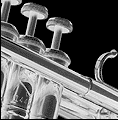


 The Gloucester, Massachusetts, firm of C.B. Fisk, widely considered
the most distinguished American organ-building organization of
the last quarter century, built the new organ. With Finney Chapel
packed to the doors, it was put through its inaugural paces in
a pair of concerts featuring Oberlin organ professors Haskell
Thomson and David Boe with music written for organs of this type.
Paul Polivnick and the Oberlin Orchestra joined in the September
28 concert, in which Boe was the soloist in Oberlin alumnus Robert
Sirota's '71 "In the Fullness of Time" (2000) and Saint-Saens'
"Organ" Symphony. Thomson took the spotlight in Joseph
Jongen's Symphonie concertante. The instrument was heard
by itself on September 29, with Boe playing music of Franck, Vierne,
and Ermend Bonnal, and Thomson opting for Louis Lefebure-Wely,
Franck, Widor, Durufle, and Messiaen. On September 30 other organists,
including quite a pleiade of Oberlin alumni, were invited to sign
up for individual times to play the instrument.
The Gloucester, Massachusetts, firm of C.B. Fisk, widely considered
the most distinguished American organ-building organization of
the last quarter century, built the new organ. With Finney Chapel
packed to the doors, it was put through its inaugural paces in
a pair of concerts featuring Oberlin organ professors Haskell
Thomson and David Boe with music written for organs of this type.
Paul Polivnick and the Oberlin Orchestra joined in the September
28 concert, in which Boe was the soloist in Oberlin alumnus Robert
Sirota's '71 "In the Fullness of Time" (2000) and Saint-Saens'
"Organ" Symphony. Thomson took the spotlight in Joseph
Jongen's Symphonie concertante. The instrument was heard
by itself on September 29, with Boe playing music of Franck, Vierne,
and Ermend Bonnal, and Thomson opting for Louis Lefebure-Wely,
Franck, Widor, Durufle, and Messiaen. On September 30 other organists,
including quite a pleiade of Oberlin alumni, were invited to sign
up for individual times to play the instrument. "I'm just so pleased that it has turned out so well as it
has. The flue stops particularly come together," Thomson
says. "I have to admit that my favorite stop is the flute
harmonique it's a wonderful example of that very important stop.
A French romantic organ more or less stands or falls on the way
this stop interacts with the other 8-foot flues the montre, the
gamba, and the bourdon as it gives power to the upper register,
richness throughout the compass, and makes way for the gamba to
give point to the low register. In this way it contributes greatly
to the blending of sonorities that results in a beautiful symphonic
sound."
"I'm just so pleased that it has turned out so well as it
has. The flue stops particularly come together," Thomson
says. "I have to admit that my favorite stop is the flute
harmonique it's a wonderful example of that very important stop.
A French romantic organ more or less stands or falls on the way
this stop interacts with the other 8-foot flues the montre, the
gamba, and the bourdon as it gives power to the upper register,
richness throughout the compass, and makes way for the gamba to
give point to the low register. In this way it contributes greatly
to the blending of sonorities that results in a beautiful symphonic
sound."  With its relatively low and busily beamed ceiling, Finney Chapel
will never have the long "roll" of reverberation all
but inseparable from the sounds of the great Cavaille-Coll organs
in Paris, Lyon, Caen, Toulouse, and Rouen. Kirkegaard thinks the
effect could still be improved by further reinforcement of the
ceiling and windows without overly muddying the sound of piano
or orchestra. But that would cost more money and require air-conditioning
the chapel.
With its relatively low and busily beamed ceiling, Finney Chapel
will never have the long "roll" of reverberation all
but inseparable from the sounds of the great Cavaille-Coll organs
in Paris, Lyon, Caen, Toulouse, and Rouen. Kirkegaard thinks the
effect could still be improved by further reinforcement of the
ceiling and windows without overly muddying the sound of piano
or orchestra. But that would cost more money and require air-conditioning
the chapel.